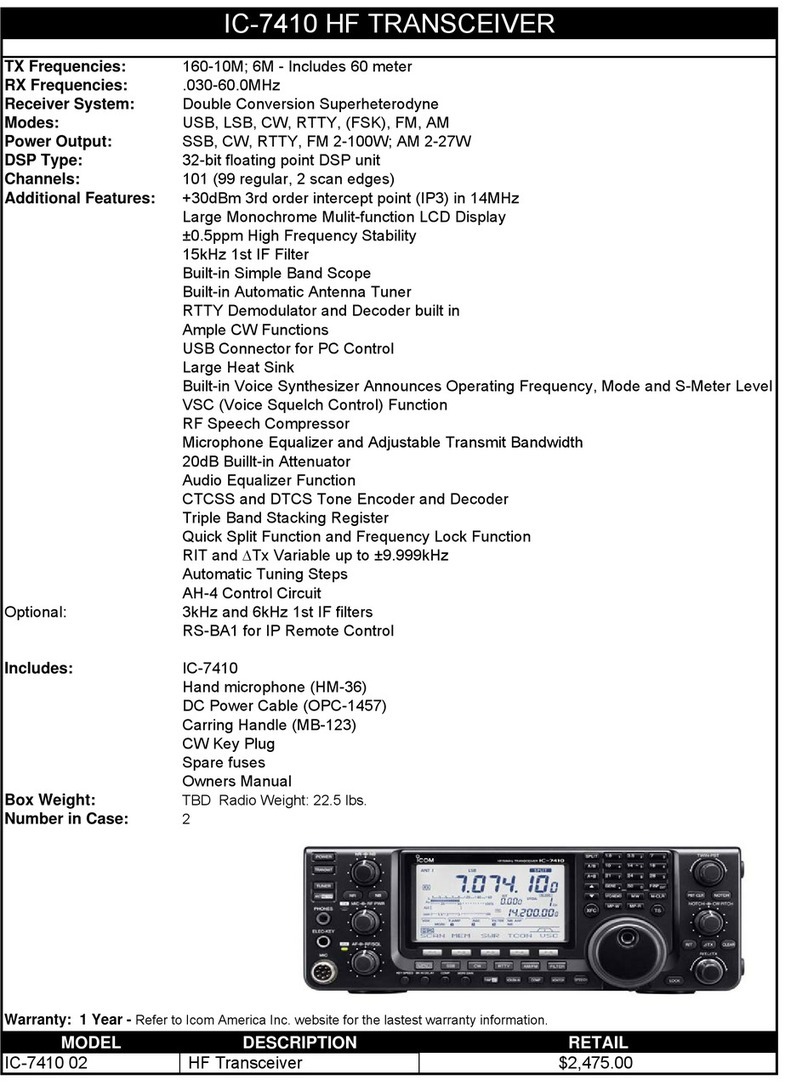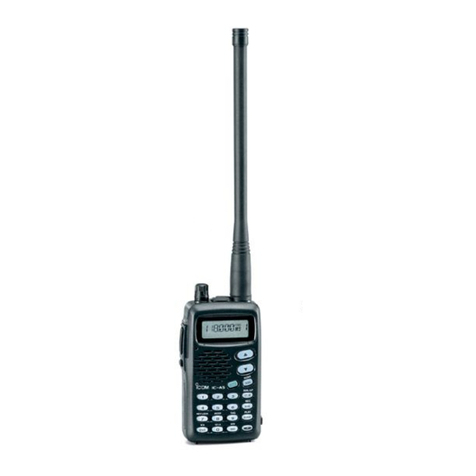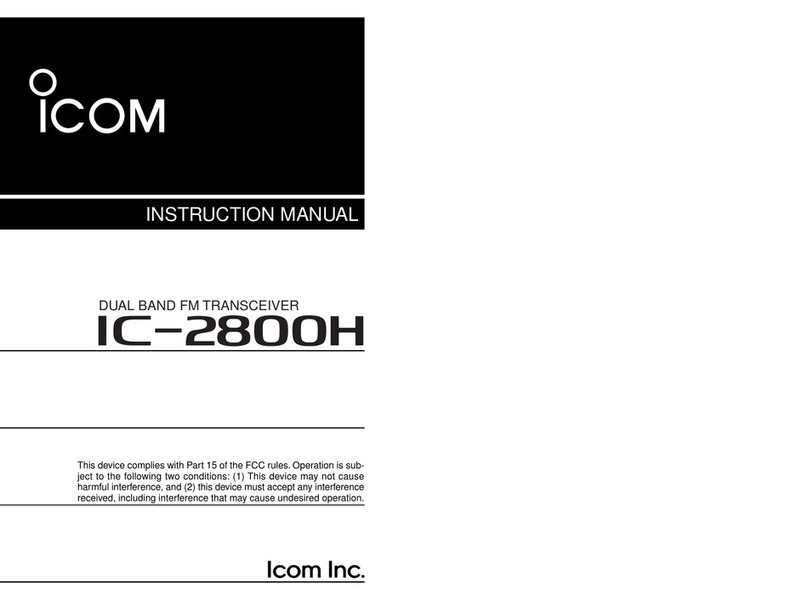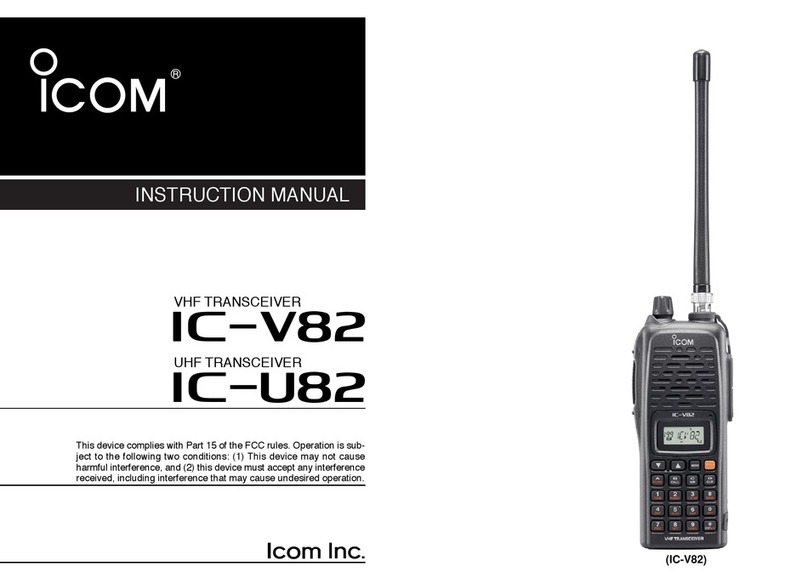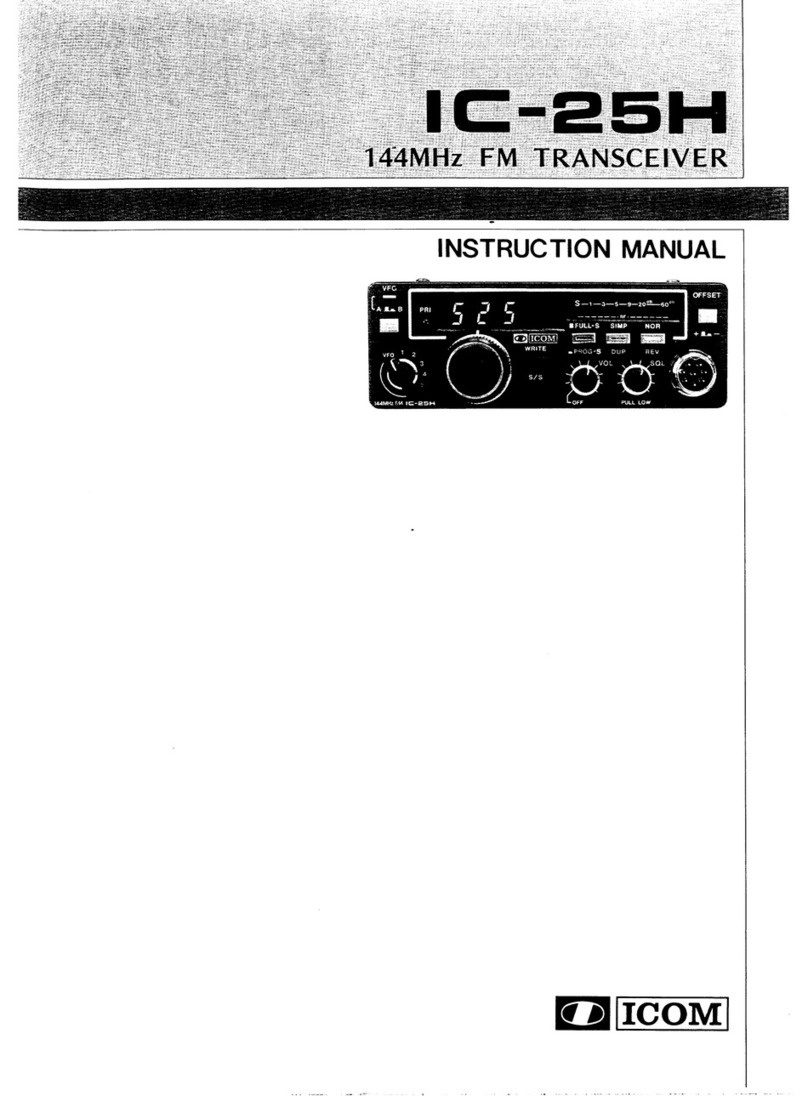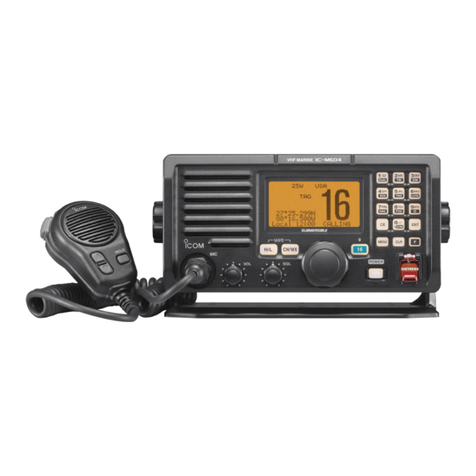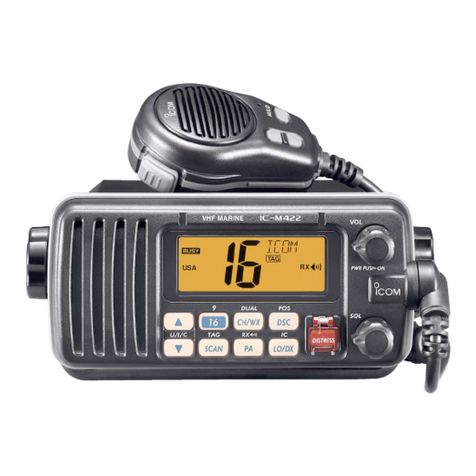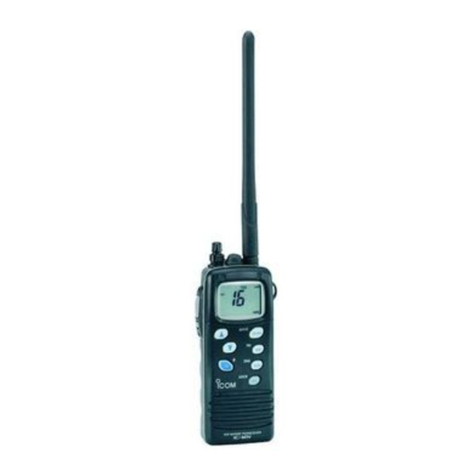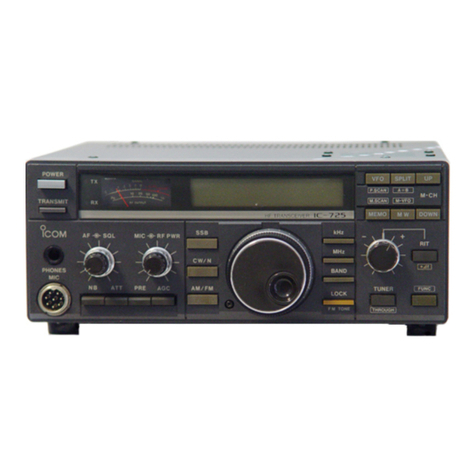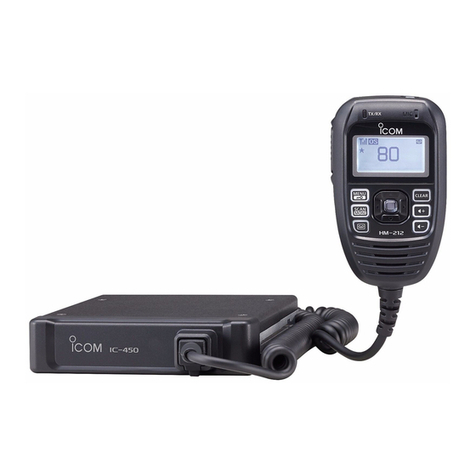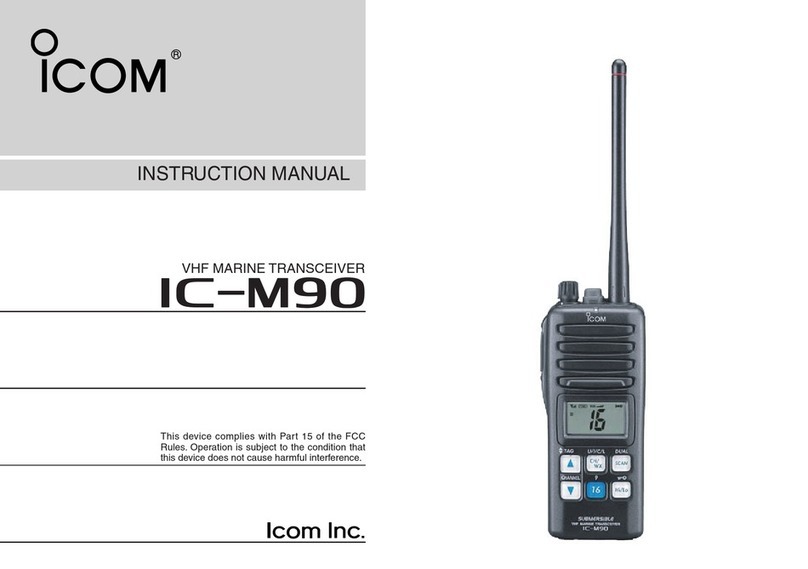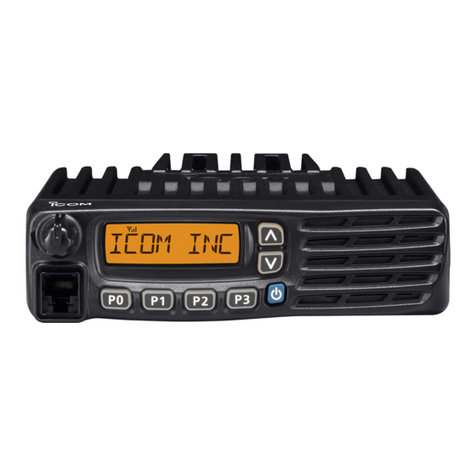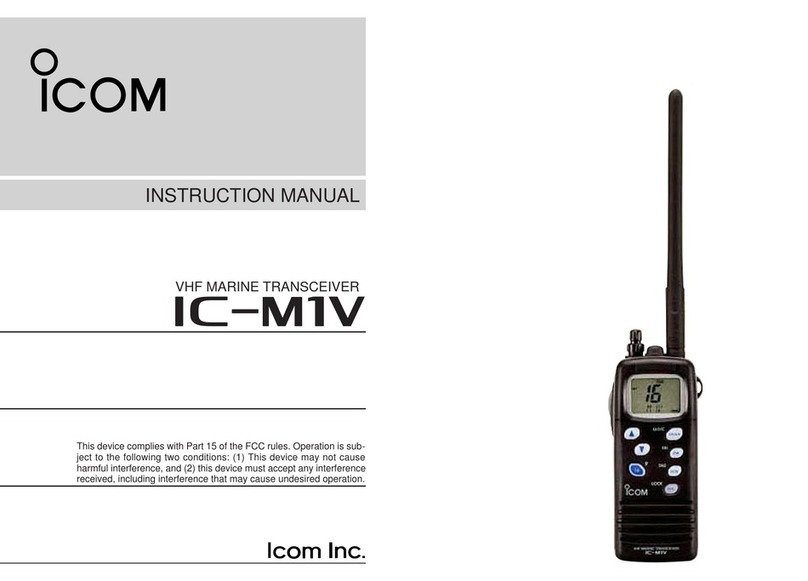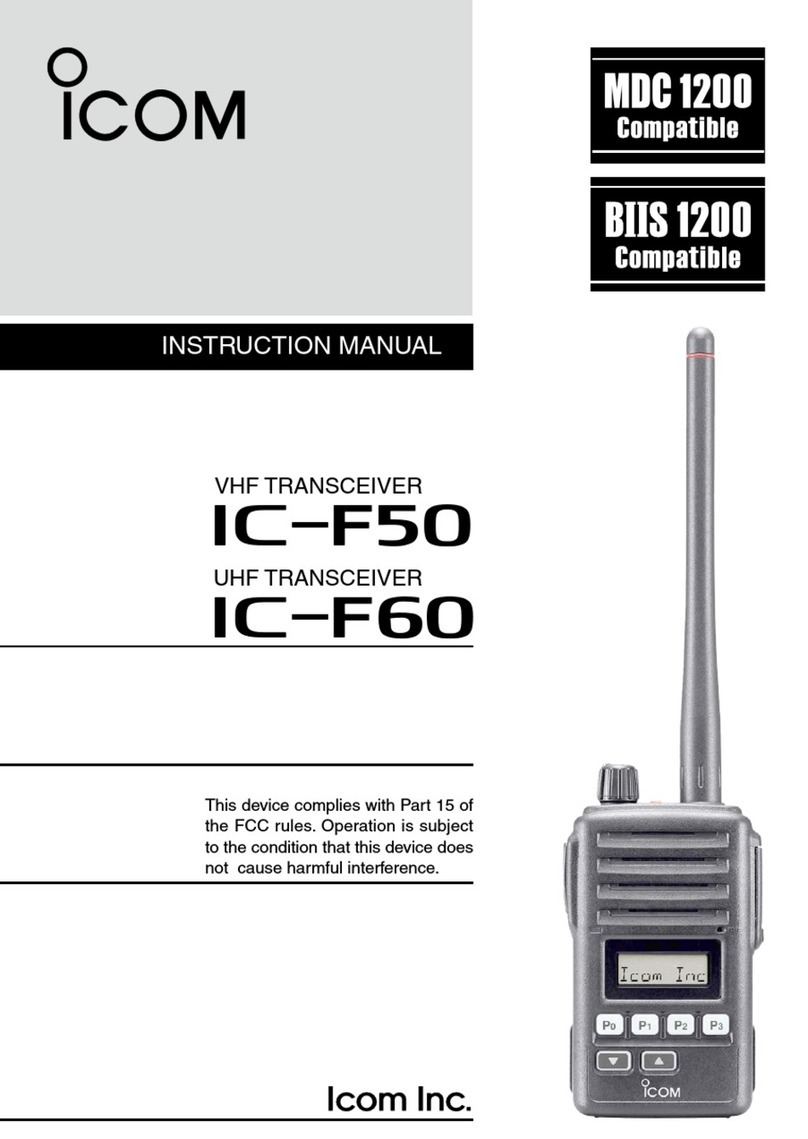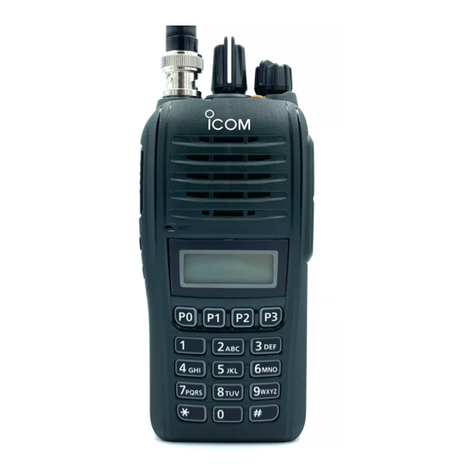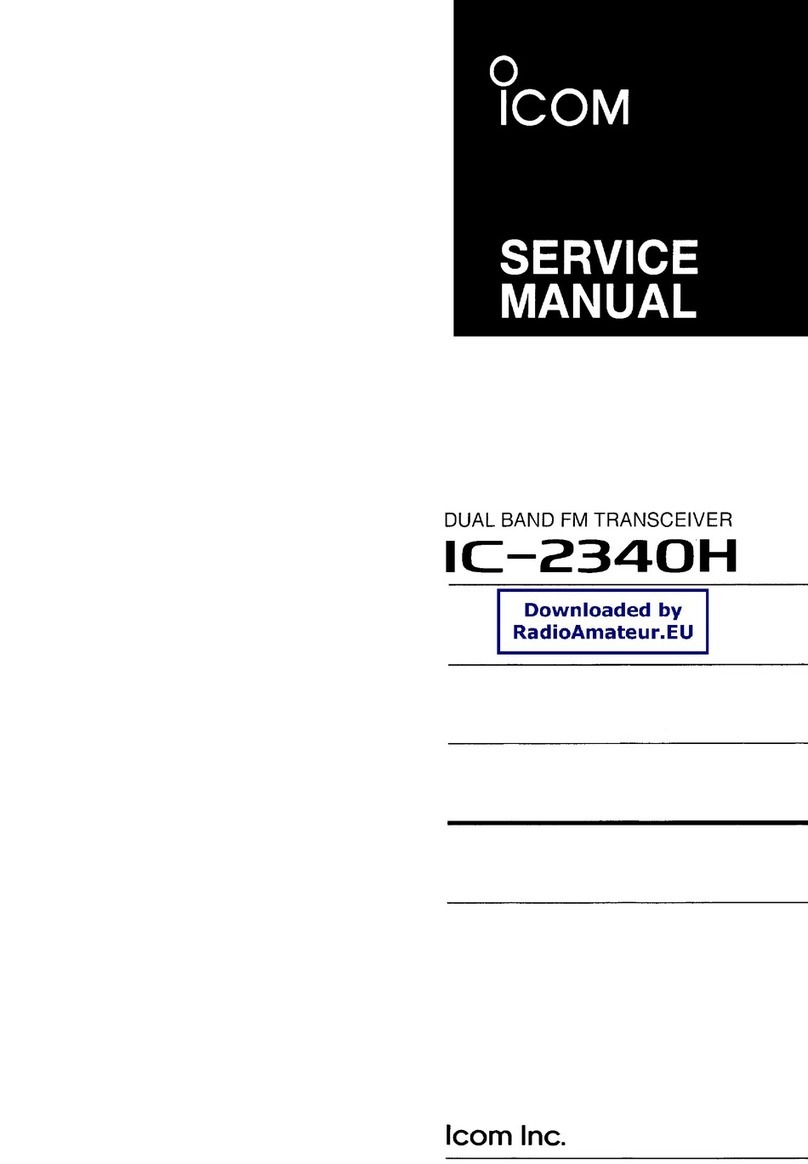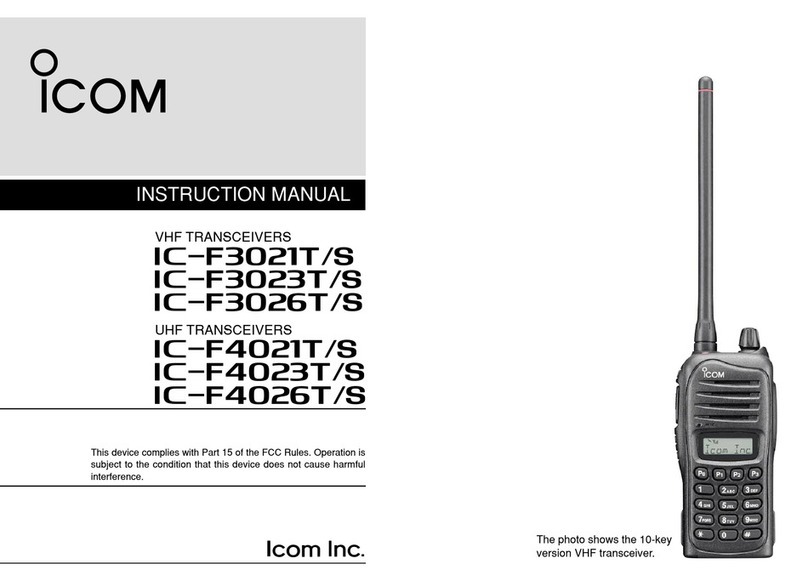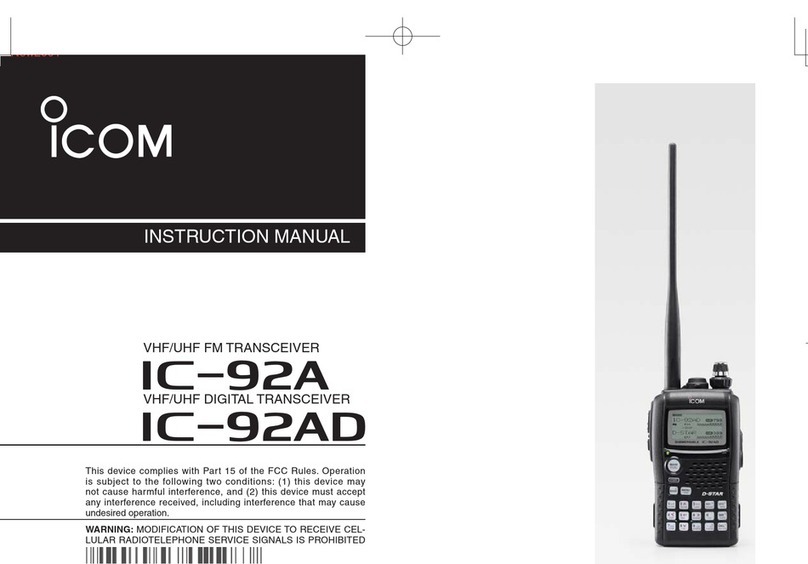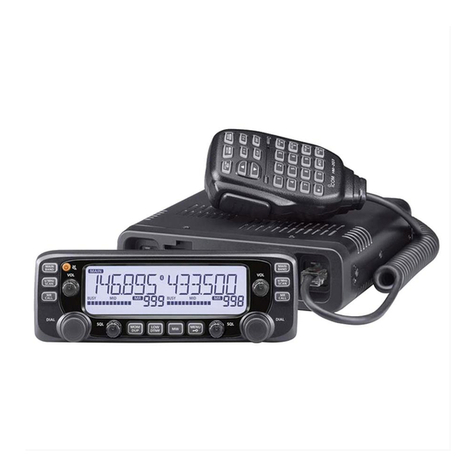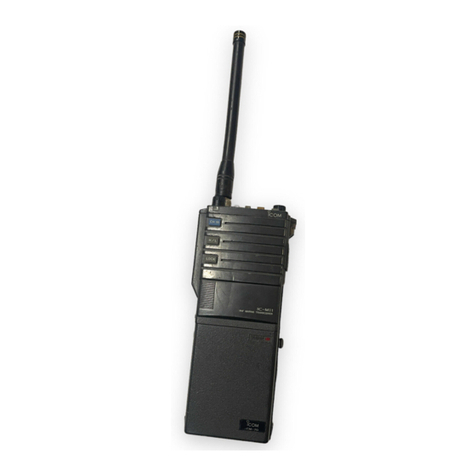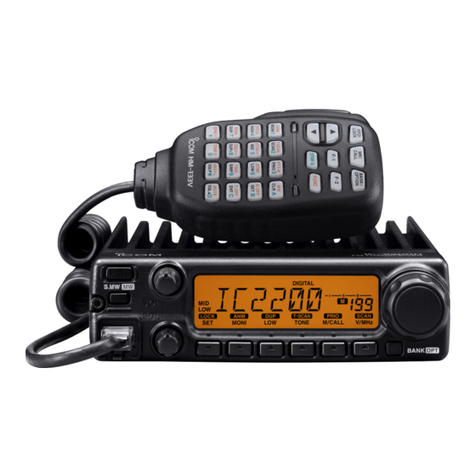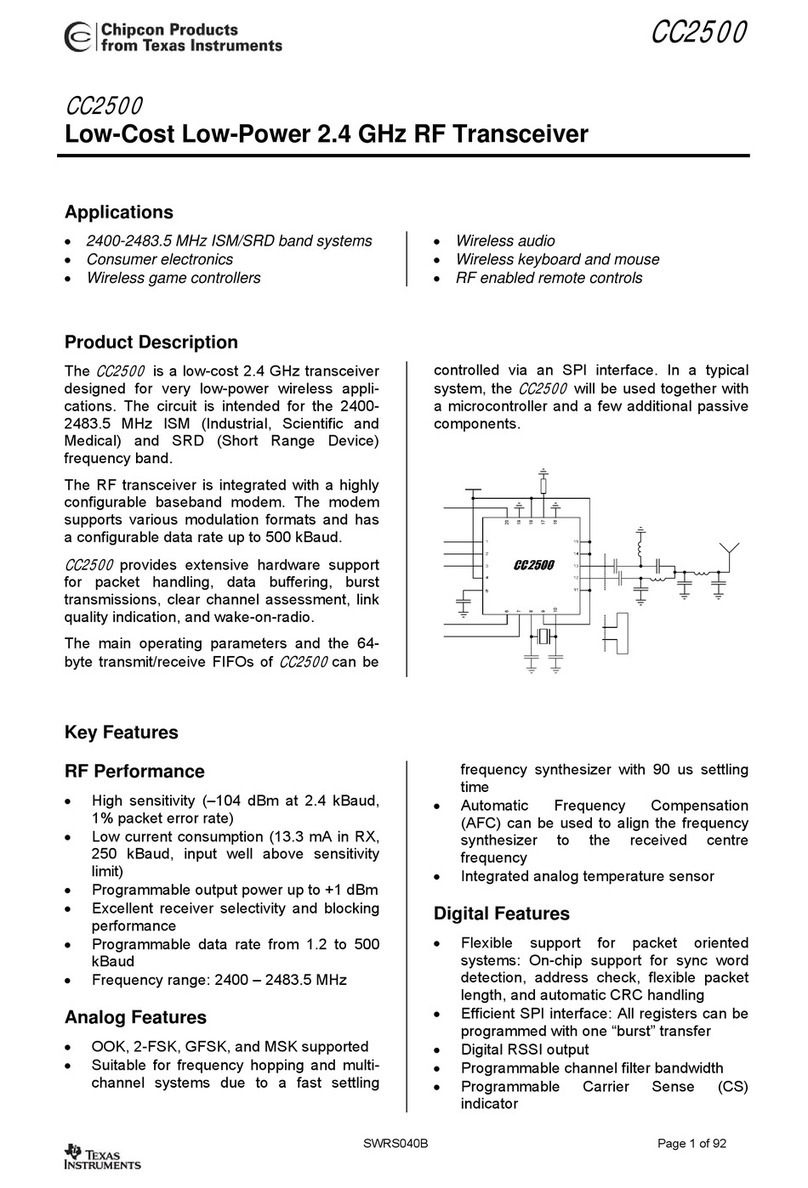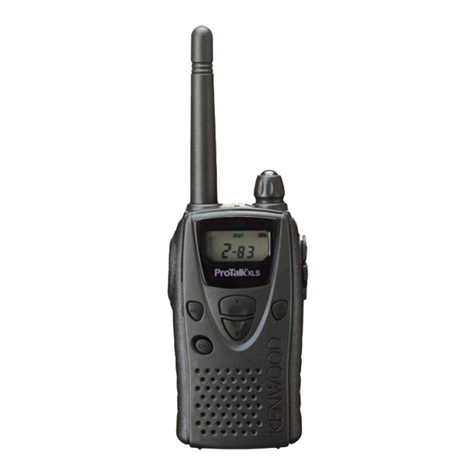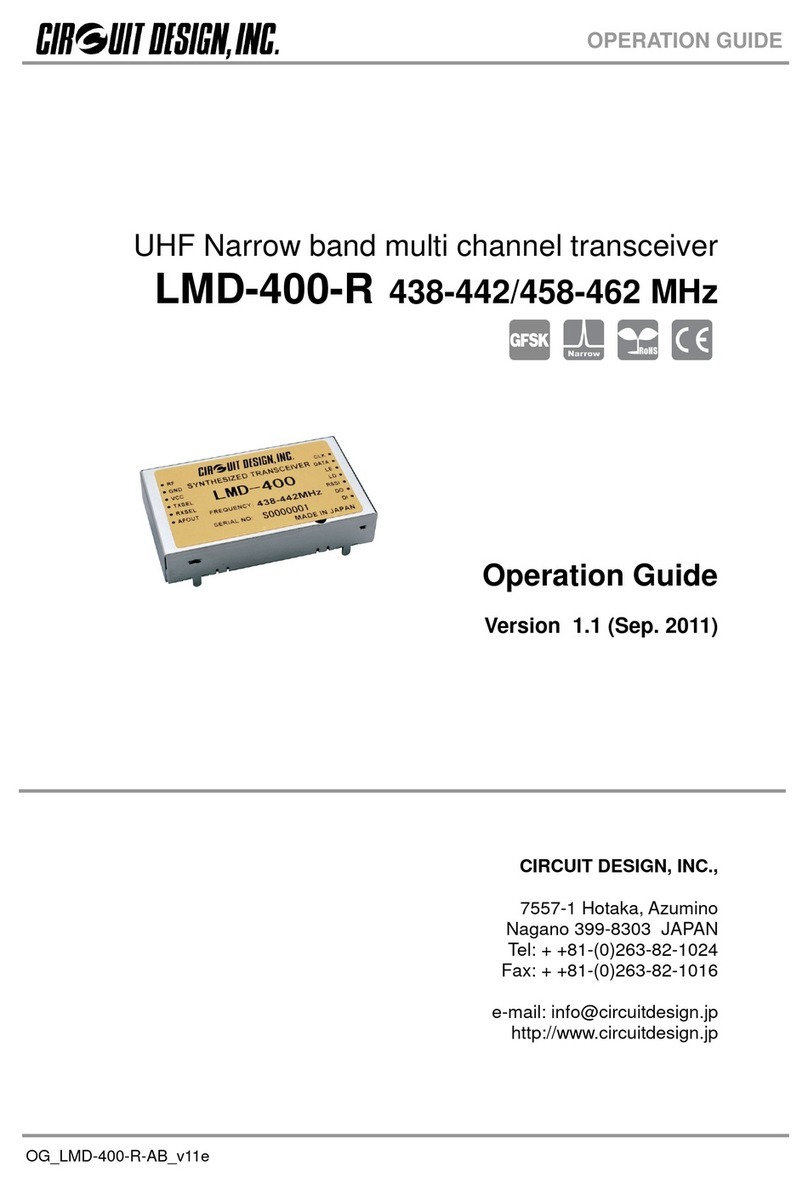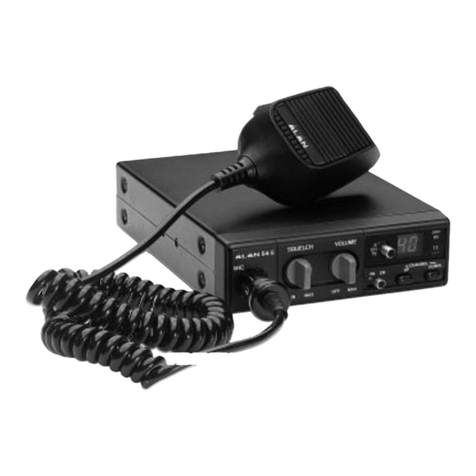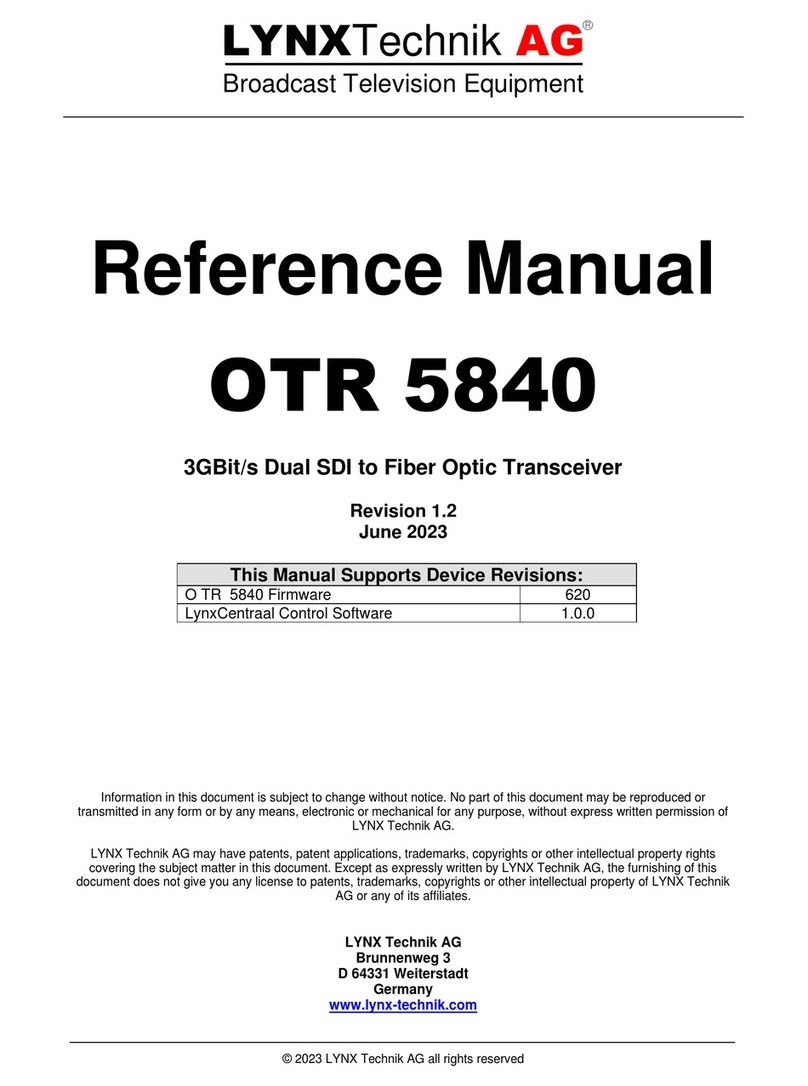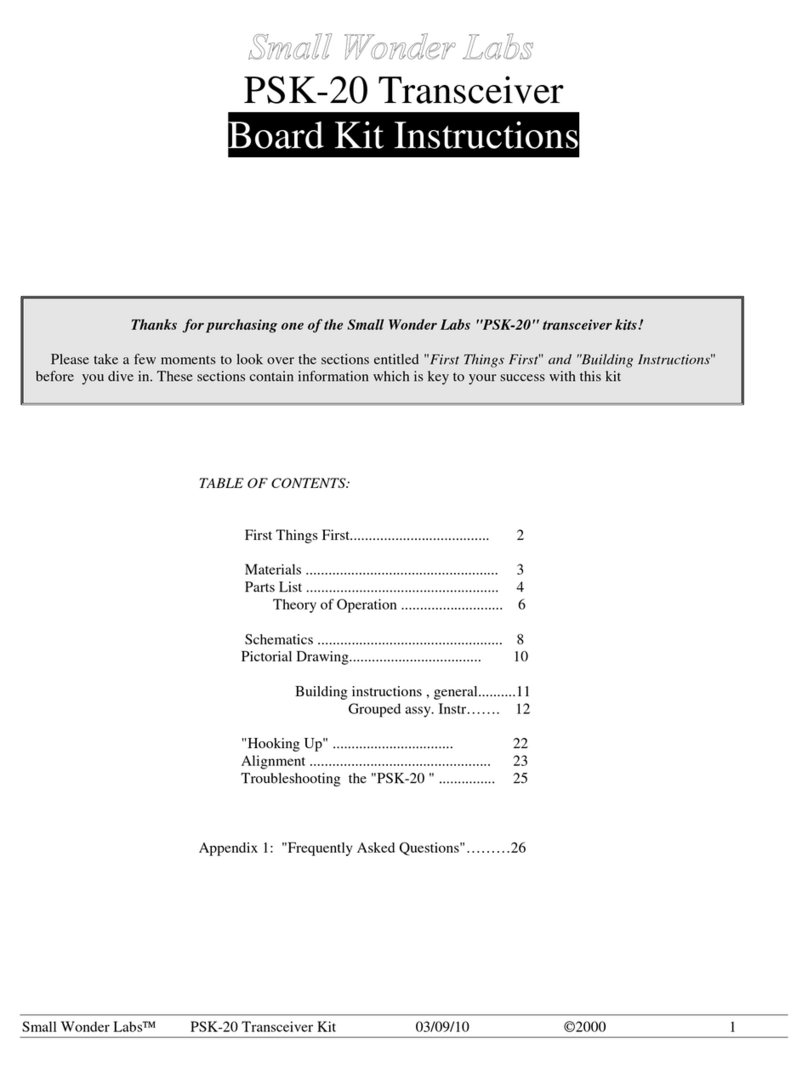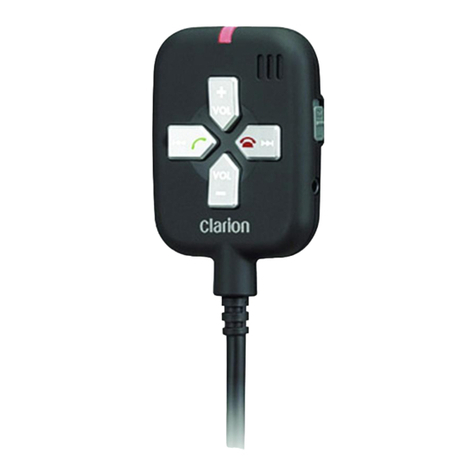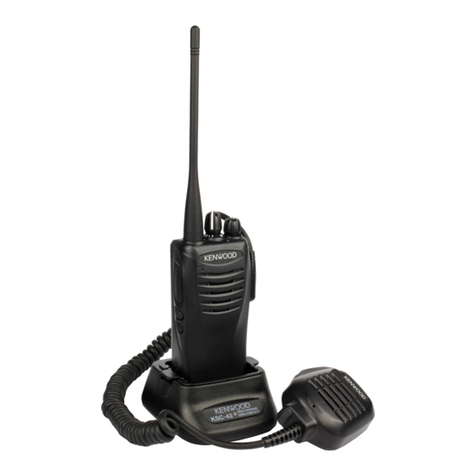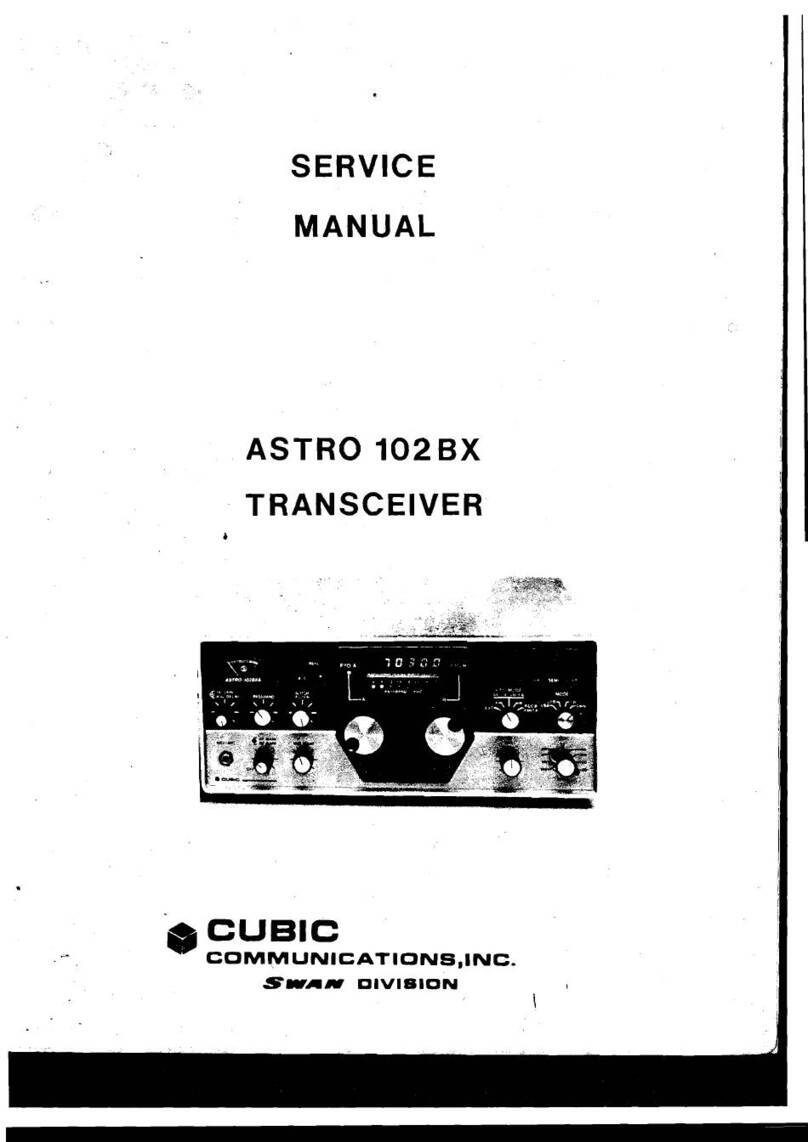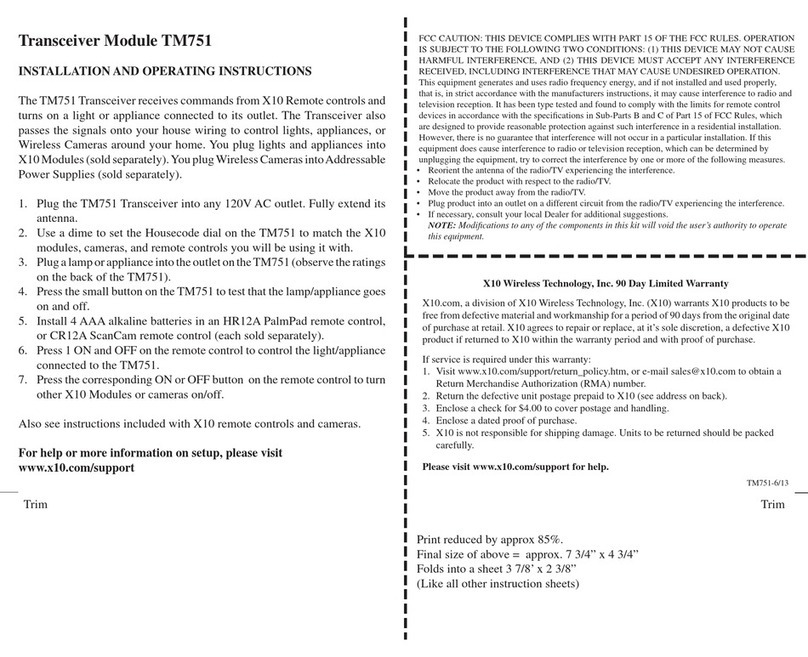Icom IC-M87 User manual

INSTRUCTION MANUAL
iM87
VHF MARINE TRANSCEIVER

i
IN CASE OF EMERGENCY
If your vessel requires assistance, contact other vessels and
the Coast Guard by sending a distress call on Channel 16.
❍USING CHANNEL 16
DISTRESS CALL PROCEDURE
1. “MAYDAY MAYDAY MAYDAY.”
2. “THIS IS ...........................” (name of vessel)
3. Your call sign or other indication of the ves-
sel.
4. “LOCATED AT .....................” (your position)
5. The nature of the distress and assistance re-
quired.
6. Any other information which might facilitate
the rescue.
RECOMMENDATION
CLEAN THE TRANSCEIVER THOROUGHLY WITH FRESH
WATER after exposure to saltwater. Otherwise, the trans-
ceiver’s keys, switches and controllers may become inopera-
ble due to salt crystallization.
NOTE: DO NOT wash the transceiver in water if there is any
reason to suspect the waterproofing may not be effective. For
example, in cases where the battery pack rubber seal is dam-
aged, the transceiver/battery pack is cracked or broken, or
has been dropped, or when the battery pack is detached from
the transceiver.

ii
FOREWORD
Thank you for purchasing this Icom product. The IC-M87 VHF
MARINE TRANSCEIVER is designed and built with Icom’s state
of the art technology and craftsmanship. With proper care this
product should provide you with years of trouble-free operation.
IMPORTANT
READ ALL INSTRUCTIONS carefully and com-
pletely before using the transceiver.
SAVE THIS INSTRUCTION MANUAL—This in-
struction manual contains important operating instructions for
the IC-M87.
EXPLICIT DEFINITIONS
FEATURES
☞22 free channels for PMR use
The IC-M87 has 22 free channels reserved for PMR
use
(146–174MHz). Wide/narrow
channel spacing is program-
mable for each channel, and CTCSS and DTCS signaling
is included.
*Appropriate license will be required.
☞Tough waterproof construction
The IC-M87 is built tough to withstand hazardous and un-
hospitable environments at sea and on land. Even if the
IC-M87 is dropped into water, it’s waterproofing* will pro-
tect it from harm. The compact and durable body meets
the military specifications (MIL-STD).
* Equivalent to JIS waterproof grade 7 or IPX7 of the corre-
sponding International Standard IEC 529 (1989). (1m depth for
30 minutes)
☞Simple operation
6 clearly labelled buttons on the front panel and the vol-
ume/power knob maximize simplicity of operation. Even
when wearing gloves, the large buttons are easy to oper-
ate. A large, clear LCD with backlighting and backlit but-
tons make night time operation simple.
WORD DEFINITION
RWARNING Personal injury, fire hazard or electric shock
may occur.
CAUTION Equipment damage may occur.
NOTE If disregarded, inconvenience only. No risk
of personal injury, fire or electric shock.

PRECAUTION
RWARNING! NEVER connect the transceiver to an
AC outlet. This may pose a fire hazard or result in an electric
shock.
RWARNING! NEVER hold the transceiver so that the
antenna is very close to, or touching exposed parts of the
body, especially the face or eyes, while transmitting. The
transceiver will perform best if the microphone is 5 to 10 cm
away from the lips and the transceiver is vertical.
NEVER connect the transceiver to a power source other
than the BP-227AX. Such a connection will ruin the trans-
ceiver.
NEVER use non-Icom battery packs/chargers to prevent
the loss of the transceiver’s good performance and warranty.
DO NOT use or place the transceiver in direct sunlight or
in areas with temperatures below –15°C or above +55°C: Ma-
rine, below –20°C or above +55°C: PMR.
KEEP the transceiver out of the reach of children.
KEEP the transceiver at least 0.9 meter away from your
vessel’s magnetic navigation compass.
iii
BE CAREFUL! The IC-M87 employs waterproof con-
struction, which corresponds to JIS waterproof specification,
Grade 7 (1 m depth for 30 min.). However, once the trans-
ceiver has been dropped, waterproofing cannot be guaran-
teed due to the fact that the transceiver may be cracked, or
the waterproof seal damaged, etc.
MAKE SURE the flexible antenna and battery pack are
securely attached to the transceiver, and that the antenna and
battery pack are dry before attachment. Exposing the inside
of the transceiver to water will result in serious damage to the
transceiver.
Icom optional equipment is designed for optimal performance
when used with this transceiver. We are not responsible for
the transceiver being damaged or any accident caused when
using non-Icom optional equipment.
Icom, Icom Inc. and are registered trademarks of Icom Incorporated
(Japan) in the United States, United Kingdom, Germany, France, Spain, Russia
and/or other countries.

iv
IN CASE OF EMERGENCY ................................................ i
RECOMMENDATION ........................................................... i
FOREWORD ....................................................................... ii
IMPORTANT ........................................................................ ii
EXPLICIT DEFINITIONS ..................................................... ii
FEATURES .......................................................................... ii
PRECAUTION .................................................................... iii
TABLE OF CONTENTS ...................................................... iv
INTRINSIC SAFETY ........................................................... v
1 OPERATING RULES ..................................................... 1
2 SUPPLIED ACCESSORIES AND ATTACHMENTS... 2–3
3 PANEL DESCRIPTION .............................................. 4–7
■Front, top and side panels ........................................... 4
■Function display .......................................................... 6
4 BASIC OPERATION ................................................ 8–12
■Channel selection ....................................................... 8
■Receiving and transmitting ....................................... 10
■Adjusting the squelch level ........................................ 11
■Automatic backlighting .............................................. 11
■Lock function ............................................................. 11
■Call channel programming ........................................ 12
■Voice scrambler operation ........................................ 12
5 SCAN OPERATION ............................................... 13–14
■Scan types ................................................................ 13
■Setting tag channels ................................................. 14
■Starting a scan .......................................................... 14
TABLE OF CONTENTS
6 DUALWATCH/TRI-WATCH .......................................... 15
■Description ................................................................ 15
■Operation .................................................................. 15
7 LAND (PMR) CHANNEL OPERATION ....................... 16
■LAND (PMR) Channel Group .................................... 16
■Function display......................................................... 16
8 SET MODE ............................................................. 17–21
■SET mode programming ........................................... 17
■SET mode items ....................................................... 18
9 BATTERY CHARGING .......................................... 22–25
■Battery charging ........................................................ 22
■Cautions .................................................................... 22
■AD-100 installation .................................................... 24
■Optional battery chargers ......................................... 25
10 SPEAKER-MICROPHONE .......................................... 26
■HM-138 Description .................................................. 26
■Attachments .............................................................. 26
11 TROUBLESHOOTING ................................................. 27
12 VHF MARINE CHANNEL LIST .................................... 28
13 SPECIFICATIONS ........................................................ 29
14 OPTIONS ...................................................................... 30
15 QUICK REFERENCE.................................................... 31
16 DOC .............................................................................. 32
17 ATEX CAUTIONS ......................................................... 33

v
INTRINSIC SAFETY
Versions of the IC-M87 which display the “EX”
marking on the serial number seal.
The approval rating for these models is II2G EEx
ib IIA T3.
WARNING! NEVER charge the BP-227AX (with/without
the transceiver) in an explosive atmosphere. The optional bat-
tery chargers are not approved as Intrinsically Safe.
When the transceiver is used in a hazardous area, the
BP-227AX MUST be attached, either the jack cover or HM-
138 MUST be attached to the speaker-microphone connec-
tor.
KEEP the transceiver and the BP-227AX clean to avoid any
risk of ignition due to the build-up of electrostatic charges.
Repair of Icom radios should only be carried out by autho-
rized Icom distributors. In particular, repair of ATEX approved
radios can ONLY be done by Icom to maintain the intrinsi-
cally safe rating. NEVER attempt to repair an ATEX ap-
proved radio. Only Icom has the repair expertise and
procedures to maintain the ATEX approval. Contact your Icom
distributor or authorised dealer for details.
The ATEX standard is described on the 94/9/EC sticker (Ex
Marking) and BP-227AX as below.
BP-227AX

1
1
OPERATING RULES
DPriorities
•Read all rules and regulations pertaining to priorities and
keep an up-to-date copy handy. Safety and distress calls
take priority over all others.
•You must monitor Channel 16 when you are not operating
on another channel.
•False or fraudulent distress calls are prohibited under law.
DPrivacy
•Information overheard but not intended for you cannot law-
fully be used in any way.
•Indecent or profane language is prohibited.
DRadio licenses
(1) SHIP STATION LICENSE
When your craft is equipped with a VHF FM transceiver, you
must have a current radio station license before using the
transceiver. It is unlawful to operate a ship station which is not
licensed.
Inquire through your dealer or the appropriate government
agency for a Ship-Radiotelephone license. This license in-
cludes the call sign which is your craft’s identification for radio
purposes.
(2) OPERATOR’S LICENSE
A restricted Radiotelephone Operator Permit is the license
most often held by small vessel radio operators when a radio
is not required for safety purposes.
The Restricted Radiotelephone Operator Permit must be
posted near the transceiver or be kept with the operator. Only
a licensed radio operator may operate a transceiver.
However, non-licensed individuals may talk over a transceiver
if a licensed operator starts, supervises, ends the call and
makes the necessary log entries.
A current copy of the applicable government rules and regu-
lations is only required to be on hand for vessels in which a
radio telephone is compulsory. However, even if you are not
required to have these on hand it is your responsibility to be
thoroughly acquainted with all pertinent rules and regulations.

2
2SUPPLIED ACCESSARIES AND ATTACHMENTS
DSupplied accessories
The following accessories are supplied: Qty.
•Swivel belt clip . . . . . . . . . . . . . . . . . . . . . . . . . . . .1
•Stopper for the swivel belt clip . . . . . . . . . . . . . . . .1
•Screws for the swivel belt clip . . . . . . . . . . . . . . . .2
•Flexible antenna . . . . . . . . . . . . . . . . . . . . . . . . . .1
•Handstrap . . . . . . . . . . . . . . . . . . . . . . . . . . . . . . .1
•Battery pack (BP-227AX) . . . . . . . . . . . . . . . . . . .1
•AC adapter (BC-147E)* . . . . . . . . . . . . . . . . . . . . .1
•Battery charger (BC-152) . . . . . . . . . . . . . . . . . . .1
*Not supplied with some version
DSwivel belt clip
To attach:
qAttach the stopper to the back of the transceiver.
wClip the belt clip to a part of your belt and insert the stopper to the
belt clip.
eOnce the transceiver is locked in place, it will swivel 360 degrees.
Supplied screws
Stopper

3
2
SUPPLIED ACCESSARIES AND ATTACHMENTS
DFlexible antenna
Connect the supplied flexible an-
tenna to the antenna connector.
CAUTION: Transmitting with-
out an antenna may damage
the transceiver.
NEVER HOLD by the antenna
when carrying the transceiver.
To remove:
Turn the transceiver upside down, and then lift up to re-
lease the transceiver from the belt clip.
RCAUTION!
HOLD THE TRANSCEIVER TIGHTLY, WHEN ATTACHING
OR REMOVING THE TRANSCEIVER FROM THE BELT
CLIP.
If the transceiver is accidentally dropped and the swivel belt
clip’s stopper is scratched or damaged, the swivel belt clip
may not work properly.
DHandstrap
Slide the handstrap through
the loop on the side of the
transceiver as illustrated at
right. Facilitates carrying.

4
3PANEL DESCRIPTION
qVOLUME CONTROL [VOL]
Turns power ON and adjusts the audio level.
wANTENNA CONNECTOR (p. 3)
Connects the supplied antenna.
eSPEAKER-MICROPHONE CONNECTOR [SP MIC] (p. 26)
Connects the optional speaker-microphone.
rSCAN [SCN•DUAL]
•Starts and stops normal or priority scan. (p. 14)
•Enters Watch mode when pushed for 1 sec. (p. 15)
tTRANSMIT POWER/LOCK SWITCH [H/L•LOCK]
•Selects high, middle (except for the German version) or
low power when pushed. (p. 10)
•Toggles the lock function ON/OFF when pushed for 1
sec. (p. 11)
yCHANNEL 16 SWITCH [16•C]
•Selects Channel 16 when pushed. (p. 8)
•Selects the call channel when pushed for 1 sec. (p. 8)
•Enters call channel write mode when the call channel is
selected and this switch is pushed for 3 sec. (p. 12)
u
r
t
i
o
!0
q
w
y
e
■Front, top and side panels
[SP MIC] jack cover
NOTE: KEEP the [SP MIC] jack cover
attached to the transceiver when the
speaker-microphone is not in use.

5
3
PANEL DESCRIPTION
w
q
Battery pack
Battery release button
ïBATTERY PACK RELEASE BUTTON
To release the battery pack:
Push the battery release button in the direction of the arrow
(q) as shown below. The battery pack is then released.
To attach the battery pack:
Slide the battery pack on the back of the transceiver in the di-
rection of the arrow (w), then lock it with the battery release
button.
*Slide the battery pack until the battery release button makes a ‘click’
sound.
CAUTION!: When pushing the battery release button,
slide the battery pack slightly in the direction of the arrow
(w) to ease release. This will prevent possible injuring to
your fingers or nails
uCHANNEL UP/DOWN SWITCHES [Y]/[Z]
•Select an operating channel. (p. 9)
•Selects the SET mode condition of item. (p. 17)
•Checks tag channels or changes scanning direction dur-
ing scan. (p. 14)
•Sets and clears the displayed channel as a tag (scanned)
channel when pushed both switches for 1 sec.
•While turning power ON, clears all tag channels in the se-
lected channel group when both switches are pushed.
iDIAL/CHANNEL GROUP SWITCH [DIAL]
•Selects one of 3 regular channels in sequence when
pushed for 1 sec. (pgs. 8, 9, 16)
- International, USA (or ATIS*) and LAND (PMR) channels are
available. *German version only
•Push to return to the condition before selecting the chan-
nel when the priority channel or the call channel is se-
lected.
oSQUELCH SWITCH [SQL] (p. 11)
•Push this switch, then set the squelch level with [Y]/[Z].
•Manually opens the squelch for channel monitoring while
pushed and held.
•While pushing this switch, turn the power ON to enter the
set mode.
!0 PTT SWITCH [PTT]
Push and hold to transmit; release to receive.

6
3PANEL DESCRIPTION
■Function display
qweruy
t
i
!1
!2
!3
!4
!5
o
!0
qTRANSMIT INDICATOR (p. 10)
Appears while transmitting.
wBUSY INDICATOR (p. 10)
•Appears when receiving a signal or when the squelch
opens.
•Blinks while monitoring.
eTAG CHANNEL INDICATOR (p. 14)
Appears when a tag channel is selected.
rSCAN INDICATOR (p. 14)
Blinks while scanning.
tLOCK INDICATOR (p. 11)
Appears while the lock function is activated.
yNARROW INDICATOR (p. 16)
Appears when narrow channel spacing is selected.
*LAND (PMR) channel group only.
uBATTERY INDICATOR
Indicates remaining battery power.
Indication
Full Middle Charging
required Discharged
Battery level

7
3
PANEL DESCRIPTION
iDUALWATCH/TRI-WATCH INDICATORS (p. 15)
“DUAL”appears during dualwatch; “TRI”appears during
tri-watch.
oSCRAMBLER INDICATOR
Appears when the optional voice scrambler is activated.
(pgs. 12, 21)
!0 DUPLEX INDICATOR
Appears when a duplex channel is selected.
!1 SUB CHANNEL READOUT
•Indicates Channel 16 during priority scan, dualwatch or
tri-watch. (p. 15)
•Indicates the SET mode item while in SET mode.
!2 CHANNEL NUMBER READOUT
•Indicates the selected operating channel number.
•In SET mode, indicates the selected condition.
!3 CALL CHANNEL INDICATOR (p. 8)
Appears when the call channel is selected.
!4 CHANNEL GROUP INDICATOR (pgs. 9, 16)
“I”appears when International; “U”appears when U.S.A.
(U.K. version only); “”appears when LAND (PMR)
channel group is selected. “ATIS”appears when the chan-
nel group in which ATIS function is activated. (German ver-
sion only)
!5 TRANSMIT POWER INDICATOR (p. 10)
•“LOW”appears when low power is selected.
•“MID”appears when middle power is selected. (Except
for the German version)
•No indication when high power is selected.

8
4BASIC OPERATION
DCall channel
Each regular channel group has a separate call channel. In
addition, each call channel is monitored during tri-watch. The
call channels can be reprogrammed and are used to store
your most often used channels in each channel group for
quick recall.
qPush [16•C] for 1 sec. to select the call channel in the se-
lected channel group.
•“CALL”and the call channel number appear.
•Each channel group may have its own call channel after pro-
gramming a call channel. See the “Call channel programming”
on p. 12 for details.
wPush [DIAL] to return to the condition before selecting the
call channel, or push [Y]/[Z] to select the operating chan-
nel.
■Channel selection
DChannel 16
Channel 16 (Distress channel) is used for establishing initial
contact with another station and for emergency communica-
tions. Channel 16 is automatically monitored during both du-
alwatch and tri-watch. While standing by, you must monitor
Channel 16.
qPush [16•C] to select Channel 16.
wPush [DIAL] to return to the condition before selecting
Channel 16, or push [Y]/[Z] to select the operating chan-
nel.
C
Push
C
Push
for 1 sec.
Channel 16 is the default setting.
(depending on version)

9
4
BASIC OPERATION
DInternational, U.S.A and ATIS* channels
There are 57 International, 58 U.S.A. and 57 ATIS* channels.
These channel groups may be specified for the operating
area.
qPush [DIAL] to select a regular channel.
wPush [Y]/[Z] to select a channel.
•“DUP”appears for duplex channels.
eTo change the channel group, push [DIAL] for 1 sec.
•International, U.S.A. and ATIS* channels can be selected in se-
quence. Depending on the setting, LAND (PMR) channel can be
selected. See the “LAND (PMR) CHANNEL OPERATION”on p.
16 for details.
U.S.A channels
International channels
ATIS channels*
Push
for 1 sec.
Push
for 1 sec.
* German version only

10
4BASIC OPERATION
qRotate [VOL] clockwise to turn power ON.
wUse the squelch function to mute any audio noise if
necessary. After pushing the [SQL] for 1 sec., the squelch
function is cut off until [SQL] is released. (default)
ePush [SQL] for 1 sec. (see the SET mode on p. 19), and
rotate [VOL] to set the audio output level.
rPush [Y]/[Z] to select the desired channel.
- When receiving a signal, “”appears and audio is emitted
from the speaker.
- Further adjustment of [VOL] may be necessary at this point.
tPush [H/L•LOCK] to select the output power if necessary.
- “LOW”appears when low power is selected; “MID”appears
when middle power is selected (except for the German version);
no indication when high power is selected.
- Choose low power to conserve battery power, choose high
power for longer distance communications.
- Some channels are for low power only.
yPush and hold [PTT] to transmit, then speak into the
microphone.
- “TX”appears.
- Channel 70 cannot be used for transmission (for GMDSS use).
uRelease [PTT] to receive.
■Receiving and transmitting
CAUTION: Transmitting without an antenna may
damage the transceiver.
IMPORTANT: To maximize the readability of your transmit-
ted signal, pause a few sec. after pushing [PTT], hold the
microphone 5 to 10 cm from your mouth and speak at a
normal voice level.
NOTE: The transceiver has a power save function to con-
serve the battery power and it cannot be turned OFF. The
power save function activates automatically when no sig-
nal is received for 5 sec.
rSet channel
wOpening the
squelch
qPower ON
eSet volume
tSet output
power
yPush and
hold to
transmit
uRelease to
receive

11
4
BASIC OPERATION
■Adjusting the squelch level
The IC-M87 has a squelch even though there is no control knob
for it. In order to receive signals properly, as well as for the scan
to function effectively, the squelch must be adjusted to the
proper level.
qPush [SQL], then adjust the squelch level with [Y]/[Z].
- “SL”indicator appears.
- There are 11 squelch levels to choose from: OP is completely
open; 10 is the tight squelch level.
- When no key is pushed for 5 sec., the transceiver returns to nor-
mal condition.
wPush [SQL] again to return to normal condition.
■Automatic backlighting
This function is convenient for nighttime operation. The auto-
matic backlighting can be activated in SET mode. (p. 19)
➥Push any key except for [PTT] to turn the backlighting ON.
•The backlighting is automatically turned OFF after 5 sec. of in-
activity.
■Lock function
This function electronically locks all keys (except for [PTT],
[SQL] and [H/L•LOCK]) to prevent accidental channel changes
and function access.
➥Push [H/L•LOCK] for 1 sec. to turn the lock function ON and
OFF.
Appears while the
lock function is used.

12
4BASIC OPERATION
■Call channel programming
The call channel key is used to select the default channel,
however, you can program your most often-used channel in
each channel group for quick recall.
qPush [DIAL] for 1 sec. several
times to select the desired chan-
nel group (INT, USA) to be pro-
grammed.
wPush [16•C] for 1 sec. to select
the call channel.
•“CALL”and call channel number
appear.
ePush [16•C] again for 3 sec.
(until a long beep changes to 2
short beeps) to enter call chan-
nel programming condition.
•Call channel number to be pro-
grammed flashes.
rPush [Y]/[Z] to select the de-
sired channel.
tPush [16•C] to program the dis-
played channel as the call chan-
nel.
•The call channel number stop
flashing.
■Voice scrambler operation
DActivating the scrambler
The optional voice scrambler provides private communica-
tions. In order to receive or send scrambled transmissions,
you must first activate the scrambler function.
q
Select an operating channel
except Channel 16 or 70.
wWhile pushing and holding
[SQL], push [SCN•DUAL].
•“SCRM”appears.
eTo turn the scrambler func-
tion OFF, repeat step w.
•“SCRM”disappears.
DProgramming scramble codes
There are 32 codes (1 to 32) available for programming. Set
the code in SET mode. In order to understand each other, all
transceivers in your group must have the same scramble code,
as well as the same scrambler unit. See page
21
for scrambler
code setting details.
Appears when the
voice scrambler
function is in use.

13
5
SCAN OPERATION
■Scan types
Scanning is an efficient way to locate signals quickly over a
wide frequency range. The transceiver has priority scan and
normal scan.
In addition, an auto scan function is available for standby con-
venience. (p. 18)
Set the tag channels (scanned channel) before scanning.
Clear the tag channels which inconveniently stop scanning,
such as digital communications.
Choose priority or normal scan in SET mode. (p. 18)
NORMAL SCAN
Normal scan, like priority scan, searches through all tag
channels in sequence. However, unlike priority scan, Chan-
nel 16 is not checked unless Channel 16 is set as a tag
channel.
CH 01 CH 02
CH 88
CH 05 CH 04
CH 03
PRIORITY SCAN
Priority scan searches through all tag channels in se-
quence while monitoring Channel 16. When a signal is de-
tected on Channel 16, scan pauses until the signal disap-
pears; when a signal is detected on a channel other than
Channel 16, scan becomes dualwatch until the signal dis-
appears.
CH 88
CH 01
CH 16
CH 02
CH 05 CH 04
CH 03

14
5SCAN OPERATION
■Setting tag channels
For more efficient scanning, add desired channels as tag
channels or clear tag channels for unwanted channels. Non-
tag channels will be skipped during scanning. Tag channels
can be assigned to each channel group (INT, USA) indepen-
dently.
qSelect the desired channel group (INT, USA) by pushing
[DIAL] for 1 sec., if desired.
wSelect the desired channel to set as a tag channel.
ePush both [Y] and [Z] for 1 sec. to set the displayed chan-
nel as a tag channel.
•“TAG”appears in the function display.
rTo cancel the tag channel setting, push both [Y] and [Z]
for 1 sec.
•“TAG”disappears.
•Clearing all tag channels in the selected channel group
While pushing and holding both [Y] and [Z], turn power ON
to clear all tag channels in the channel group.
■Starting a scan
Set the priority scan function, scan resume timer and auto
scan function in advance, using SET mode. (p. 18)
qSelect the desired channel group (INT, USA) by pushing
[DIAL] for 1 sec., if desired.
wPush [SCN•DUAL] to start priority or normal scan.
•“SCAN”blinks in the function display.
•“16”appears during priority scan.
•When a signal is received, scan pauses until the signal disap-
pears or resumes after pausing 5 sec. according to SET mode
setting. (Channel 16 is still monitored during priority scan.)
•Push [Y]/[Z] to check the scanning tag channels, to change the
scanning direction or resume the scan manually.
eTo stop the scan, push [SCN•DUAL].
•“SCAN”disappears.
•Pushing [PTT], [16•C] or [DIAL] also stops the scan.
Push Scan starts. Push
to stop the scan.
Scan pauses when receiving
a signal and audio is emitted.
DUAL DUAL
[Example]: Starting a normal scan.
Other manuals for IC-M87
8
Table of contents
Other Icom Transceiver manuals
